

Table of contents
- Editor's note
- Psychoactive & hallucinogenic plants
- henbane
- tumbling punch
- deadly nightshade
- hydrangeas
- angel trumpet
- Datura
- catnip
- lettuce
- Common mugwort
Psychoactive and hallucinogenic plants often come from exotic countries, but these can also be found in the home garden. Many of the plants have been used by humans since ancient times to achieve an intoxicating effect. However, since some of the plants contain strong toxins, consumption is often dangerous and can have serious consequences. Even small amounts can lead to a fatal overdose.
Editor's note
We strongly advise against consuming the plants mentioned here (or even just components) in a self-experiment. Please leave the processing of these plants for medicines and remedies to the professionals. In all areas where parts of the plants are processed, people work (usually even under laboratory conditions). with many years of training and a great deal of background knowledge to produce something useful from the poisons.
A notice:
In the event of symptoms of poisoning, contact the poison control center immediately and call the emergency number.
Psychoactive & hallucinogenic plants
To the surprise of many hobby gardeners, some psychoactive and hallucinogenic plants grow in their own garden. Since many of the plants are very dangerous, consumption is generally not recommended. Anyone who is not mentally stable should under no circumstances attempt this on themselves. In most cases it is very difficult to estimate the quantities of the active ingredients in the plants. Depending on the location and other conditions, there can be significant fluctuations in the active ingredients. Therefore, uncontrolled intake can lead to overdoses, which can even be life-threatening. People have been experimenting with plants known for their intoxicating effects for thousands of years. The various parts of the plant are either simply or elaborately prepared and then taken. The goal is the intoxicating effect on the psyche and a change in the state of consciousness.
- Are referred to as natural drugs
- Leaves are used either as a tea or as a smoked product
- Berries often taste unpleasant
- Therefore eat in combination with food
- Can have stimulating or calming effects
- Ingestion often leads to violent reactions
- Dry mouth and dilated pupils are typical
- Consumption leads to an increase in heart rate up to a racing pulse
- Other symptoms include sensitivity to light and blurred vision
- Continuous use can even lead to blindness
- In extreme cases, cause fatal respiratory paralysis
henbane

The henbane bears the botanical name Hyoscyamus niger and has spread widely in Europe and Germany. The plant has been known for its intoxicating effects since ancient times. In the Middle Ages, the plant was closely associated with the superstition surrounding witchcraft, as it was used for rituals. For ingestion, extracts are obtained from the plants, which are also used in medicine. However, the limit values of an intoxicating to toxic dosage are close together. For this reason, severe poisoning with fatal consequences can occur extremely quickly. Due to the alkaloids it contains, henbane is used in combination preparations for complaints in the muscles and in the respiratory tract, as well as the urinary and digestive tract. In addition, the oil extract is used externally for rubbing in for rheumatic pains in the joints.
- Plant can grow 1-2 meters high
- Recognizable by sticky hairy leaves
- Forms yellowish flowers
- Settles wildly at rubble dumps, along the way and in the garden
- Belongs to the highly poisonous plants
- Has both psychoactive and hallucinogenic effects
- Contains atropine, hyoscyamine and scopolamine
- Dilates the pupils and relieves spasms
- Has a stimulating effect in small doses
- In larger doses, the herb has a soporific effect
- Paralyzes the central nervous system in case of overdose
- Even 5 milligrams of the alkaloids are too much
- First there is unrest, then confusion
- Then, after a deep sleep, death occurs
Hints:
Even today, henbane has a reputation as a witch plant, so the herb continues to be used for self-experimentation. However, due to the harmful effects on health, it is not recommended.
tumbling punch
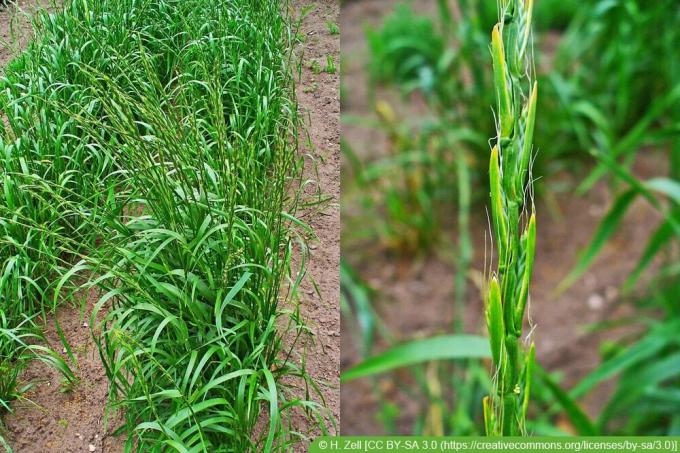
H. Zell, Lolium temulentum 002, edited by Hausgarten, CC BY-SA 3.0.
Taumel-Lolch is called in botany Lolium temulentum referred to and originally comes from the Near East. In the meantime, the grass has also spread to Germany and the rest of the world due to its robust properties, as it can even grow on deserted land. Therefore, it can also happen that the psychoactive plant settles in the home garden. Tumbling Punch distorts perception and causes very strong perceptual changes. However, it is not advisable to consume it, as even a small dose can lead to unpleasant effects and disturbances in the coordination of movements. Although a fatal outcome after consumption is rather rare, the physical disorders are extremely severe and can even last for several days in an emergency.
- Green to blue-green grass plant with long spikes
- Stiff culms stand upright and are very rough to the touch
- Reaches a maximum growth height of 75 cm to 100 cm
- Often grows in cornfields and roadsides
- Contains the psychoactive ingredient temulin
- Expressed by greatly dilated pupils
- Induces drunkenness, staggering, and confusion upon consumption
- Causes vomiting, cramps and tremors
- May cause headaches, blurred vision and day blindness
- In the worst case, paralyzes the airways
Tip:
In folk medicine, Taumel-Lolch is used as a homeopathic remedy, both for calming and for gout and rheumatism.
deadly nightshade
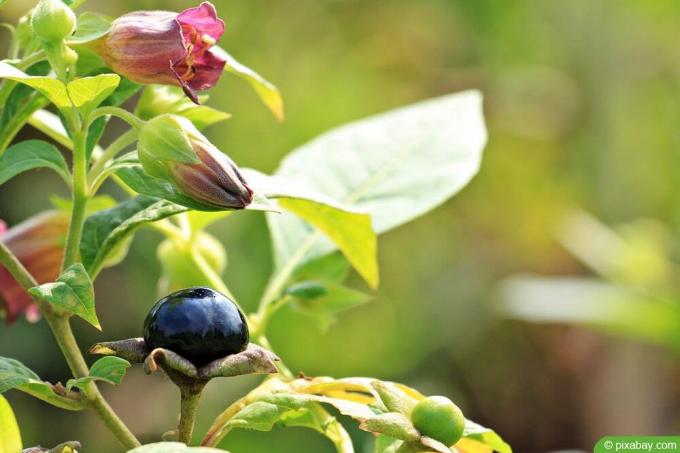
The deadly nightshade bears the botanical name Atropa belladonna and belongs to the nightshade family. The plant is widespread in Germany and also grows in many a garden. The plant has been used for mind-expanding ointments and tinctures since the Middle Ages. Nowadays deadly nightshade is used in homeopathy as belladonna and for various Purposes used mainly to treat problems with the respiratory tract and in the stomach, intestines, bladder and bile ducts cure. However, since even small amounts can have fatal consequences, private consumption is not recommended.
- Belongs to the perennial plants
- Can grow up to 2 meters high
- Recognizable by shiny black berries
- Is rich in hallucinogenic alkaloids in all parts of the plant
- After ingestion, the pupils dilate extremely
- Face becomes very red and voice hoarse
- Even small doses are harmful
- It comes to vomiting, excitement and tachycardia
- Overdose leads to unconsciousness
- In extreme cases, death occurs from respiratory paralysis
hydrangeas
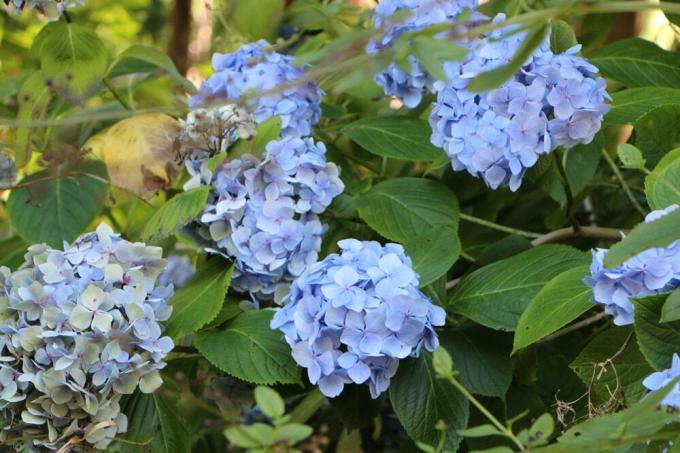
Also widespread in the local gardens is the hydrangea, which in botany as Hydrangea arborescents is known. Both the young shoots of the hydrangea and the flowers and leaves cause a hallucinogenic intoxication. Therefore, these parts of the plant are often consumed by smoking instead of hash and marijuana.
- Distinctive ornamental shrub with an upright habit
- Blooms in many colors
- Contains hydrangin, hydrangin enol and saponins
- Hydrocyanic acid compounds are also included
- Ingredients are released when smoking
- Consumption can be very dangerous
angel trumpet

The angel's trumpet bears the botanical name Datura suaveolens, due to its magnificent growth, the plant is also often referred to as the trumpet tree. Thanks to its attractive appearance, the plant has become very popular in this country, especially as a container plant. The leaves of the angel's trumpet in particular are used as an intoxicant and are mixed with cannabis and smoked.
- Recognized by trumpet-shaped and hanging flowers
- Flower color varies between yellow, orange, pink and white
- Forms large and rough leaves
- All parts of the plant above ground contain hallucinogenic alkaloids
- Can be smoked or consumed as a tea
- Smoking causes mild hallucinogenic phenomena
- If taken orally, fever-like visions appear
Datura
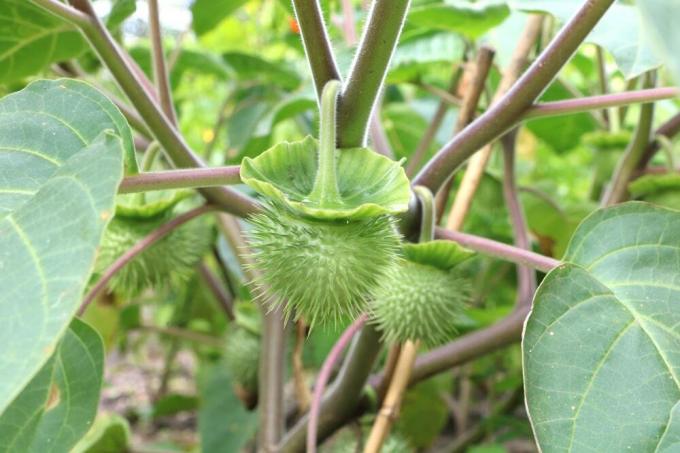
Datura carries the botanical name Datura Stramonium and belongs to the nightshade family. The plant originally occurs in Asia and North America, but it has also become established in Germany. In many cultures, the leaves are smoked to get intoxicated. In addition, various parts of plants and seeds are pressed into a brew or boiled as tea. However, due to the highly toxic properties, consumption can be very dangerous. Since the plant also has healing powers, it was used medicinally in the past to treat asthma and nervousness. However, since the toxicity is greater than the healing power, the jack apple is no longer used in medicine.
- Recognized by large, funnel-shaped flowers
- Bright white or violet blue flowers
- Forms prickly fruit capsules
- Occasionally grows wild in meadows or along roadsides
- Contains hallucinogenic alkaloids
- Has a strong hypnotic effect
- Duration of effect can last up to 36 hours
- Crazy dreams come up
- But user is not really sleeping
- Has a stimulating effect on heartbeat and digestion
- Promotes salivary secretion
- Greatly dilates the pupils
catnip
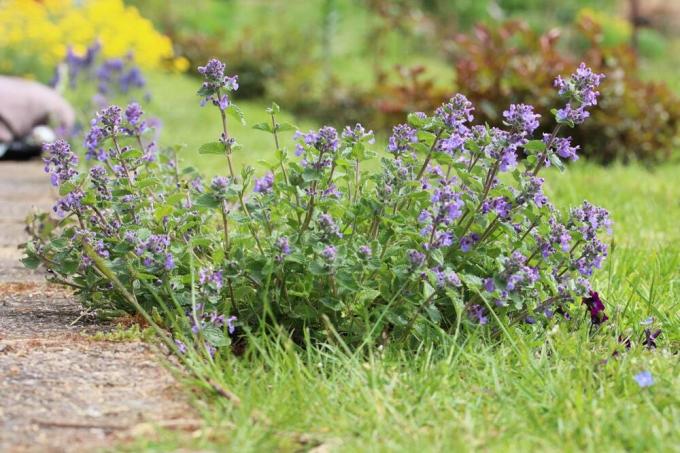
The real catnip is called in botany as Nepeta cataria and is a native plant with psychoactive properties. The name came about because cats like to get high on it. The plant can be found throughout Central Europe and often grows wild along paths and roadsides. Since the effects are very light, consumption is harmless. Because of its attractive appearance, catnip is often planted in rock and natural gardens.
- Fancy perennial with blue-violet flowers
Often grows wild in hedges - Has a mildly stimulating effect
- In larger doses it tends to be calming and sedative
- There are no serious side effects
- For psychedelic effects, herb must be consumed regularly
- The effect only sets in after a few days
- Either drink as a tea or smoke
lettuce

The wild lettuce bears the botanical name Lactuca virosa and is also known in this country as stinky lettuce and wild lettuce. The native plant originally comes from southern Europe and has spread from there to many other countries. The plant has been used as a natural sedative and aphrodisiac for thousands of years. Both the leaves and the milky sap, the so-called lactucarium, are used. The plant is often found on heavily overgrown roadsides and meadows.
- Can reach heights of growth between 60 cm and 2.5 m
- White and milky juice comes out of injured areas
- At a mild dose, it has a sedative and analgesic effect
- Doses that are too high lead to symptoms of poisoning
- These include severe headaches and tachycardia
- Uncontrolled sweating occurs
- In wild plants, the active ingredient content is difficult to estimate
Common mugwort
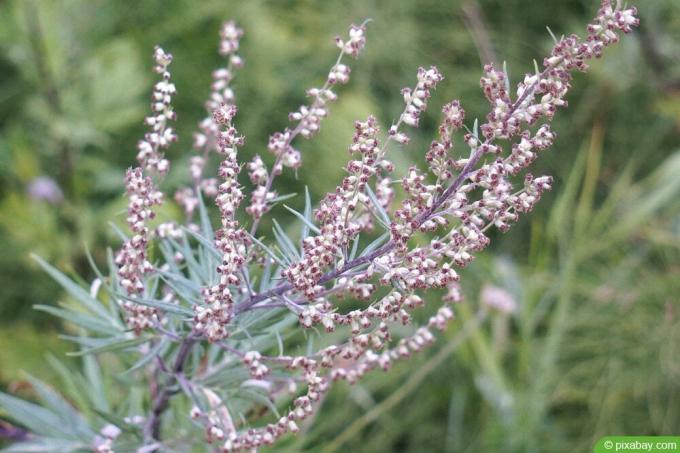
The mugwort is called in botany Artemisia vulgaris and is one of the psychoactive plants with a long tradition. The plant occurs almost all over the world and has also established itself in Germany. The reason for the psychoactive effects are the essential oils contained in mugwort, which can vary greatly in their active ingredient content depending on the location.
- Robust, herbaceous and quite inconspicuous plant
- Can reach heights of growth between 70 and 180 cm
- Contains falvonoids, camphor, sesquiterpenes, thujone and triterpenes
- Mild and slightly psychedelic effect
- Has an energizing and stimulating effect
- Finds its use as a natural aphrodisiac
- High dose has mind-altering effects
 garden editorial
garden editorial I write about everything that interests me in my garden.
Learn more about Exotic Plants
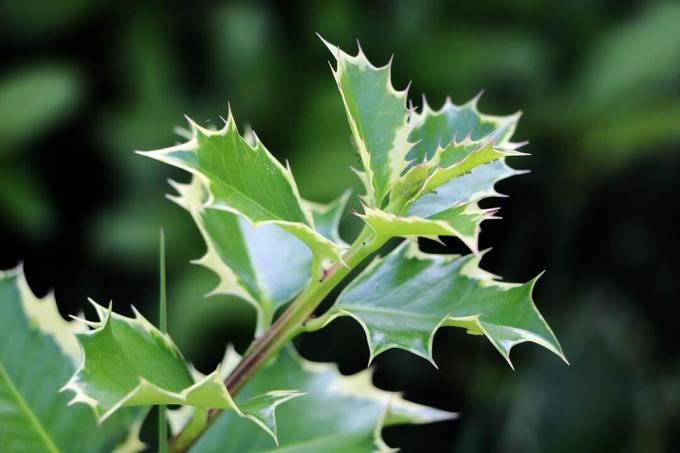
Holly, holly: care from A to Z
The European holly is one of the evergreen plants. It reaches a height of up to five meters and is ideal as a Christmas decoration or garden shrub. The native, although rarely occurring plant is the only native representative of the Ilex family and is particularly easy to care for and robust.
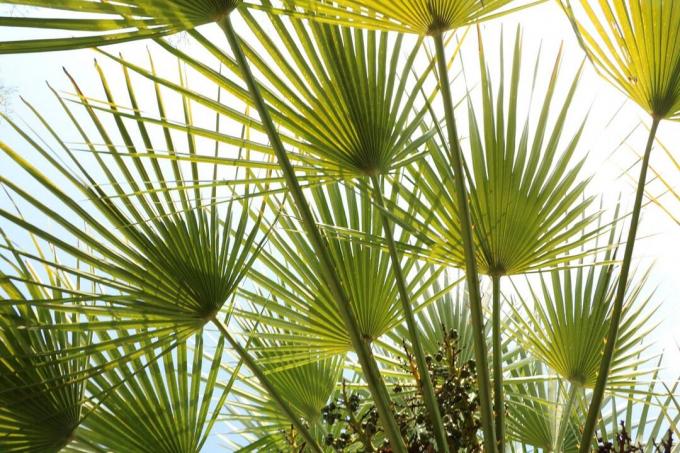
Dwarf palm, Chamaerops humilis: care instructions
The dwarf palm remains small enough that it can also be cared for in the room. However, it also cuts a fine figure in the garden. You can find out here how it is maintained and what needs to be considered.

Dwarf date palm, Phoenix roebelenii: Care from A-Z
The dwarf date palm (Phoenix roebelenii) is a particularly small, actually the smallest palm species of its genus. But that doesn't make them any less decorative. It is the most filigree and elegant date palm and hardly grows higher than one meter.

Growing vanilla plants: 11 tips for care
The vanilla plant is truly exotic in Central Europe and cannot be found in every garden. Vanilla planifolia forms the aromatic pods for which the plant is known. The cultivation of a vanilla plant is easily possible with the right care tips.

Kangaroo Paw: Caring for the kangaroo plant
Kangaroo paws are exotic plants native to southwestern Australia. Considering the care instructions, Kangaroo Paw can also thrive in Central European conditions. Maintenance requires a little more effort. If the plant gets enough attention, it will thank you with magnificent inflorescences.
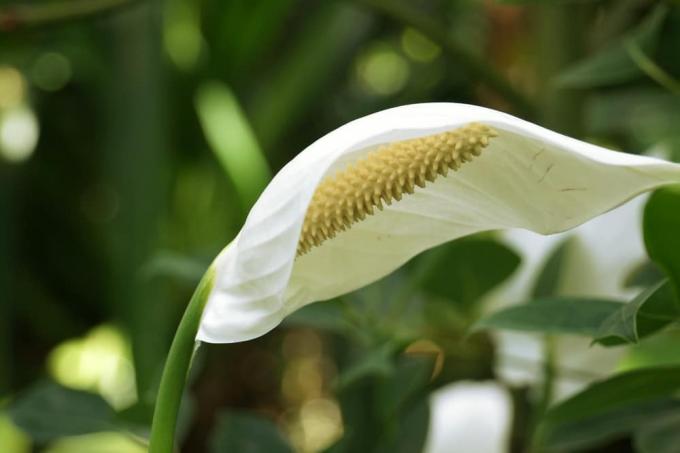
Einblatt, Spathiphyllum: care from A to Z
Because of simple! The single sheet draws everyone's attention with its extravagant appearance. The imposing flower gives sophisticated rooms that certain something. If the houseplant is in the right place, hardly any care is required. The breeder can find out here what demands Spathiphyllum places on their location.
